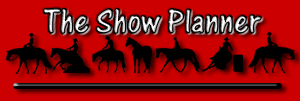 |
|
Show Horse Promotions Mary Murray
|
What is a Quarter Horse and.......Where are the other 3/4?The Quarter Horse is most definitely a full-sized horse. He is named for his ability to run a quarter of a mile faster than any other horse in the world. The Quarter Horse is also known for his heavily-muscled physique, as well as his even disposition, athletic ability and versatility. The American Quarter Horse can trace his roots to Arab, Turk and Barb breeds that were brought to North America by Spanish explorers and traders. The actual beginning of the breed was in 1611, when a select group of stallions from Spanish breeds were shipped from England. The resulting cross produced a new type of horse that was heavily muscled and able to run short distances faster than any previously known breed. Quarter Horses were a part of colonial America, and as the country grew, so did the popularity of the American Quarter Horse. He helped conquer and settle the West, easily pulling farm wagons and plows, fighting battles with Native Americans, and quickly containing herds of cattle. The Quarter Horse helped in many day-to-day activities in colonial life. He helped carry Pony Express riders, brought preachers to isolated places of worship, and rushed doctors to the homes of injured frontiersmen. The Quarter Horse got his name from the match races that settlers held for entertainment. These races, that matched two horses against each other, were seldom more than 440 yards. From this short running distance came the term, "quarterpather," which evolved into the "colonial quarter of a mile running horse," and eventually "the American Quarter Horse." The Quarter Horse found his second home with the West's sprawling ranches, where his weekdays were spent cutting cattle, roping and branding calves, brush riding and performing other ranch chores. But on the weekend, he helped with the cowboy's weekend entertainment - the rodeo circuit. The American Quarter Horse Association (AQHA) was formed in Amarillo, Texas, in 1940, and Quarter Horses began to be registered, first in Texas and Oklahoma. The breed soon spread in popularity around the country. The first known Quarter Horses arrived in Ohio in the late 1940's, and appear to have been purchased more for their golden palomino color than their Quarter Horse bloodlines. However, interest in this "new" breed was strong, and in 1951, the Ohio Quarter Horse Association was organized. Today the Quarter Horse is known as the world's most versatile breed, and there are in excess of three million horses registered worldwide with the American Quarter Horse Association. More than 49,000 registered Quarter Horses live in Ohio, and many more have at least some Quarter Horse ancestors. Quarter Horse owners number more than one million and are found in all 50 states and 64 countries worldwide. You'll still find the Quarter Horse on ranches and racetracks, but you'll also find him in show arenas, bridle trails and back yards around the country. In spite of our machine-filled and technology-filled world, the Quarter Horse continues to touch people's hearts much as he did more than 300 years ago. Article written by Connie Lechleitner
|
|
||||||||
